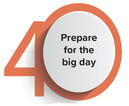Are You Ready? 6 Necessary Federal Retirement Steps
December 29th, 2021 | 3 min. read

How do you know when you’re ready to retire from the federal workforce? It’s not always an easy decision. Because it’s not only a matter of whether you want to retire but also can you retire yet.
On one hand, you have the financial elements to figure out: How big is your FERS benefit? How much can you sustainably withdraw from your TSP account? When should you file for Social Security?
Then, on the other side are the equally important lifestyle considerations: Are you no longer interested in your job? What activities do you want to pursue in retirement? How is your health?
These and many other questions are why choosing when to retire takes careful planning. Based on our experience helping federal workers, we find it helpful to do a step-by-step review to size up your readiness for a comfortable retirement.
With that goal in mind, we’ve created this federal retirement readiness checklist. Each step is important for retiring with greater confidence and security.

Create a financial plan
The first and most important step is to create a financial plan.
A financial plan is essential for many reasons, especially to help you determine your financial ability to retire. It provides an accurate assessment of your current financial situation and all the steps you need to take to reach your retirement goals. Further, a comprehensive financial plan can help you incorporate financial steps to take when things go other than planned.

Determine your retirement income
Next, you want to figure out just how much income you can expect from your various financial assets – FERS pension, TSP account, IRAs, Social Security, etc.
Start with your guaranteed income sources: your pension and Social Security benefit. You can request a FERS pension estimate based on factors such as your years of service and estimated retirement date. Through the Social Security Administration at SSA.gov, you can review your Social Security benefit statement.
Another primary source of retirement income is likely your TSP savings. Look at your TSP and other retirement account balances to estimate how much you will have saved by retirement as well as what reasonable amount you can take from those accounts each year.
Lastly, consider your other potential sources of income. For example, an inheritance, rental property or even part-time work.

Estimate how much money you need to fund your retirement lifestyle
Once you have an idea of how much you can expect from your assets, pair it with how much you plan to spend in retirement. Based on your desired retirement lifestyle, how much do you expect to spend each month? If there is a mismatch, don’t worry. There are several things you can do to get your finances in order.
Firstly, you want to make sure you have 3-6 months of living expenses saved as an emergency fund. This will act as a liquid safety net should something unexpected happen.
You can then review your current budget and estimated retirement budget to identify any expenses you can cut or reduce (unused memberships and subscriptions, dining out, etc.).
Prior to retirement, you want to pay off your debt, especially high-interest debt like credit card balances. Also, try to fund large projects (home repairs and updates) or large purchases (vacation home, RV, etc.) before you retire.
Now, if you’re dissatisfied or uncertain about your federal retirement readiness, then it’s a good sign you need more time and should repeat everything above as needed.
When you are satisfied, start taking these following steps:

Prepare for your retirement date
Now that you know you’re on track financially to retire, you have to take steps to make it actually happen.
Begin with setting a specific FERS retirement date. This is something worth considering with an adviser and, if you’re married, your partner.
Also, you will want to review your investment portfolio and adjust it as necessary since it is more important to preserve your retirement savings now than grow them.
Insurance coverage is another big part of retirement preparation. You will want to evaluate your health insurance plan options, keeping in mind Medicare kicks in at age 65. If a Federal Employees Health Benefits (FEHB) program is desired, make sure you are signed up for 5 years prior to retirement. Additionally, decide what you want to do with your Federal Employees' Group Life Insurance (FEGLI).
Perhaps, the best way to determine if you’re ready is with a retirement test run. If you are able to, consider a retirement test run by living off only your planned retirement income for 3-6 months and note if any changes to your plan are necessary.

Plan for life in retirement
Retirement planning isn’t just about getting you there, but also about managing your affairs IN retirement.
For one, there are quality of life issues to consider, not least of which is simply what you want to do once you don’t have to work anymore.
On the financial side, you should discuss tax withholdings with your CPA or accountant. Other important steps are planning for Required Minimum Distributions and evaluating potential Roth conversions each year in retirement.
To ensure your family is cared for and your wishes fulfilled, you will also want to make sure your estate plan is in place and that you’ve discussed options for long-term care should you need it.

Seek professional help
By now, you may have gotten a better sense that retirement is a big decision, one that you may not want to answer on your own. Therefore, you should consider getting professional advice.
A financial adviser can present you with an entirely personalized and comprehensive retirement plan that includes a variety of estimations based on your FERS benefit, TSP plan and all other assets. Further, a professional can suggest different strategies to take that you may not realize are available to you.
If you have any questions or would like some guidance from a financial adviser on what this means for you, please reach out to us – we would love to help you.
To help keep track of your progress toward retirement, download our convenient Federal Retirement Readiness Checklist
As a financial adviser, Kurt takes a comprehensive approach to help clients work toward their financial goals by providing wealth management tools including retirement planning, investment portfolio advice and tax strategies. He specializes in federal government benefits and is a Chartered Retirement Planning Counselor.

